catch & release
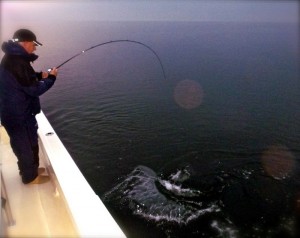 It’s January on the Chesapeake Bay. It’s freezing. It’s windy. It’s snowy-sleety-foggy-and-rainy-miserable. It’s a fine time to stay home in front of a comfortable fire and dream of warmer seasons. On the other hand, these are perfect conditions to catch & release trophy striped bass in Maryland. To get ’em, you gotta want ’em. And I mean, really want ’em.
It’s January on the Chesapeake Bay. It’s freezing. It’s windy. It’s snowy-sleety-foggy-and-rainy-miserable. It’s a fine time to stay home in front of a comfortable fire and dream of warmer seasons. On the other hand, these are perfect conditions to catch & release trophy striped bass in Maryland. To get ’em, you gotta want ’em. And I mean, really want ’em.
When it comes to winter fishing, you have to be motivated enough to put up with some misery. One of the definitions for dedication in Webster’s Online Dictionary is, a solemn commitment of your life or your time to some cherished purpose or goal. Everyone I know who is good at anything got that way because of their dedication. Simply put, the key to success in any endeavor is an extreme level of commitment. Now, let’s talk rockfish.
It’s miserable out there. It’s striped bass weather. If catching and releasing big fish is your cherished goal, why aren’t you fishing?
![1229121347-1[1]](http://www.chesapeakelighttackle.com/wp-content/uploads/2012/12/1229121347-11-300x220.jpg) By all accounts, 2012 was an unusual year for fishing. For me, it was absolutely strange at times. I jigged up my biggest striper of the year on the first day of the year, a 49-incher that might have pushed 50-pounds. It was the only fish I caught. A few days later I got another 47-incher and another one about that size on the next day. Each time it was only one fish per day. Is one fish worth five hours or more of casting? When they’re that size, I think so! Those were some of my biggest fish of 2012, but I’ve been lucky enough to jig up a few more mid-40s class fish since then including this pretty 45-incher I caught in the snow this week. Warm water discharge (WWD) fishing was good last spring, but we really had to pick our days. Our most successful times were early-morning windy weekdays when it was raining or snowing. The WWD big fish bite is always very specific. I explain how to get the trophies in my book, Chesapeake Light Tackle, An Introduction to Light Tackle Fishing on the Chesapeake Bay. Read More!
By all accounts, 2012 was an unusual year for fishing. For me, it was absolutely strange at times. I jigged up my biggest striper of the year on the first day of the year, a 49-incher that might have pushed 50-pounds. It was the only fish I caught. A few days later I got another 47-incher and another one about that size on the next day. Each time it was only one fish per day. Is one fish worth five hours or more of casting? When they’re that size, I think so! Those were some of my biggest fish of 2012, but I’ve been lucky enough to jig up a few more mid-40s class fish since then including this pretty 45-incher I caught in the snow this week. Warm water discharge (WWD) fishing was good last spring, but we really had to pick our days. Our most successful times were early-morning windy weekdays when it was raining or snowing. The WWD big fish bite is always very specific. I explain how to get the trophies in my book, Chesapeake Light Tackle, An Introduction to Light Tackle Fishing on the Chesapeake Bay. Read More!
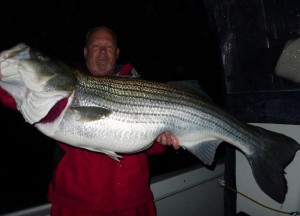 The third in a series of entries about the senses striped bass use to find their prey, here’s a look at how we can trigger more strikes by understanding how stripers hear and feel. It’s no secret that fish can be either attracted or repelled by sound. One of the biggest mistakes I see from rookie Chesapeake Bay fishermen is making too much noise. Every hunter knows the importance of stealth. When I was a kid, my dad taught me to walk lightly in the woods and to avoid stepping on sticks or limbs that might crack. He also showed me how to control a cough or sneeze and advised me to regulate my breathing in order to be more stealthy. Later, I sat through U. S. Army basic training and NCO academy classes stressing the importance of noise discipline in combat. Avoiding excessive noise when you’re fishing seems like common sense, but I’m always amazed when I see a boatload of fishermen roar up on a fishing spot, laughing and shouting with radio blaring and engine running.
The third in a series of entries about the senses striped bass use to find their prey, here’s a look at how we can trigger more strikes by understanding how stripers hear and feel. It’s no secret that fish can be either attracted or repelled by sound. One of the biggest mistakes I see from rookie Chesapeake Bay fishermen is making too much noise. Every hunter knows the importance of stealth. When I was a kid, my dad taught me to walk lightly in the woods and to avoid stepping on sticks or limbs that might crack. He also showed me how to control a cough or sneeze and advised me to regulate my breathing in order to be more stealthy. Later, I sat through U. S. Army basic training and NCO academy classes stressing the importance of noise discipline in combat. Avoiding excessive noise when you’re fishing seems like common sense, but I’m always amazed when I see a boatload of fishermen roar up on a fishing spot, laughing and shouting with radio blaring and engine running.
Obviously, stripers can be put off by noise, but they can be attracted by the sounds they’ve learned to associate with food. To a casual observer, it might seem like a quiet world beneath the water, but it’s really a noisy environment: Drumfish drum, croakers croak, baitfish bolt, crustaceans click, even crawling crabs contribute to the convoluted cacophony of sound. Striped bass hear low-pitched subaquatic sounds better than humans. They have an auditory range that starts on the low end at 15 sound waves per second (Hz) and tops out on the high side at about 15,000 Hz. Humans can’t hear sounds much lower than 20 Hz, but we can usually hear high pitched sounds better than rockfish. The angler’s challenge is to amplify the sounds that trigger strikes, while masking the ones that send fish packing. Read More!
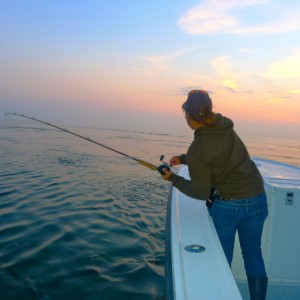 In the last CLT entry, I wrote about the five reasons why Chesapeake Bay stripers attack a lure: hunger, reaction, competition, territory protection, and curiosity. When fish are hungry, they’re easy to catch. Almost any lure or technique will work on hunger-feeding fish. Unfortunately, most of us don’t have the time or resources to constantly run around looking for schools of voracious fish. If you’re like me, you have to fish in the limited time you have available, and you probably stay close to home. While we may occasionally happen upon groups of ravenous fish, most of the stripers we encounter are hard to catch. In order to be consistently successful, we have to provoke strikes from fish that may not be particularly inclined to bite. Strike producing lures are especially important right now since we have trophy rockfish migrating in and out of the Bay. Our chances for catching-and-releasing a 50-pounder on light tackle are better than at any other time of year, but migrating fish have other things on their minds besides eating. Big fish get bigger by being smart and getting smarter. To catch them, we need to cast lures that will provoke strikes by appealing to their five senses; sight, sound, smell, feel and taste. I call the formula 5 by 5. By that, I mean we can consider the five reasons why fish strike, then use lures designed to appeal to each of their five senses in order to come up with the best of all possible strike triggers. In this installment we’ll look at striped bass eyesight. Read More!
In the last CLT entry, I wrote about the five reasons why Chesapeake Bay stripers attack a lure: hunger, reaction, competition, territory protection, and curiosity. When fish are hungry, they’re easy to catch. Almost any lure or technique will work on hunger-feeding fish. Unfortunately, most of us don’t have the time or resources to constantly run around looking for schools of voracious fish. If you’re like me, you have to fish in the limited time you have available, and you probably stay close to home. While we may occasionally happen upon groups of ravenous fish, most of the stripers we encounter are hard to catch. In order to be consistently successful, we have to provoke strikes from fish that may not be particularly inclined to bite. Strike producing lures are especially important right now since we have trophy rockfish migrating in and out of the Bay. Our chances for catching-and-releasing a 50-pounder on light tackle are better than at any other time of year, but migrating fish have other things on their minds besides eating. Big fish get bigger by being smart and getting smarter. To catch them, we need to cast lures that will provoke strikes by appealing to their five senses; sight, sound, smell, feel and taste. I call the formula 5 by 5. By that, I mean we can consider the five reasons why fish strike, then use lures designed to appeal to each of their five senses in order to come up with the best of all possible strike triggers. In this installment we’ll look at striped bass eyesight. Read More!
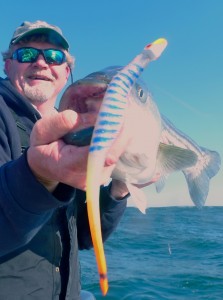 Along with sneaking in a couple of catch-and-release fishing trips, I’ve been reading all I can lately about why we catch fish with ease on some days, and why we cant buy a bite at other times. I can’t say I’ve solved that mystery, but I’ve included most of the knowledge I’ve gained in a PowerPoint slide show that I will present over the next couple of months to area fishing clubs. If you attended the Annapolis Saltwater Fishing Expo last weekend, you’ve already seen this show, but don’t be surprised if it morphs into a somewhat different format as I present it to different groups and organizations. I learn more every time I talk to fellow fishermen, pick up a book, read a magazine article, look at a website, and (especially) when I go fishing. Here’s a sneak preview of my Strike Triggers presentation:
Along with sneaking in a couple of catch-and-release fishing trips, I’ve been reading all I can lately about why we catch fish with ease on some days, and why we cant buy a bite at other times. I can’t say I’ve solved that mystery, but I’ve included most of the knowledge I’ve gained in a PowerPoint slide show that I will present over the next couple of months to area fishing clubs. If you attended the Annapolis Saltwater Fishing Expo last weekend, you’ve already seen this show, but don’t be surprised if it morphs into a somewhat different format as I present it to different groups and organizations. I learn more every time I talk to fellow fishermen, pick up a book, read a magazine article, look at a website, and (especially) when I go fishing. Here’s a sneak preview of my Strike Triggers presentation:
Have you noticed that some fishermen seem to steadily catch big fish and regularly have successful days even when others don’t? What are they doing differently? In my opinion, one trait of consistently productive fishermen is an appreciation for the concept of strike triggers. They may not always call it that, but you can pretty well bet that good fishermen are incorporating techniques in their lures and lure presentations that trick fish into biting even when they’re not particularly inclined to eat. It starts with a good understanding of the five reasons why striped bass attack a lure. Read More!
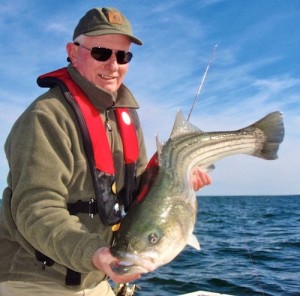 Last December, I caught up with my friend Gaylon Thompson at one of my light tackle seminars in Severna Park, Maryland. During the few minutes we had to talk, we wondered if we might be able to get in a fishing trip in early 2012. I was very excited when Rich Jenkins called me last week to say he and Gaylon were heading down to Virginia to fish in the ocean Monday, and I was invited. He also invited Jamie Clough. We’ve been hearing about the coastline bite for a while now from Wild Bill and other fishermen who follow the migration. Even though I’m turning up a few hard-to-catch but very big fish here in the Bay, we couldn’t resist giving it a go. Our first challenge was deciding whether to fish the Chesapeake Bay Bridge Tunnel, or the ocean. We called, emailed, and Facebooked everyone we could think of seeking advice. Some of our friends came though, especially “Hillbilly Boater” Jack, and a couple of Jamie’s buddies. I also got some good info from some of Tattoo Charlie’s buds on Facebook. Read More!
Last December, I caught up with my friend Gaylon Thompson at one of my light tackle seminars in Severna Park, Maryland. During the few minutes we had to talk, we wondered if we might be able to get in a fishing trip in early 2012. I was very excited when Rich Jenkins called me last week to say he and Gaylon were heading down to Virginia to fish in the ocean Monday, and I was invited. He also invited Jamie Clough. We’ve been hearing about the coastline bite for a while now from Wild Bill and other fishermen who follow the migration. Even though I’m turning up a few hard-to-catch but very big fish here in the Bay, we couldn’t resist giving it a go. Our first challenge was deciding whether to fish the Chesapeake Bay Bridge Tunnel, or the ocean. We called, emailed, and Facebooked everyone we could think of seeking advice. Some of our friends came though, especially “Hillbilly Boater” Jack, and a couple of Jamie’s buddies. I also got some good info from some of Tattoo Charlie’s buds on Facebook. Read More!


